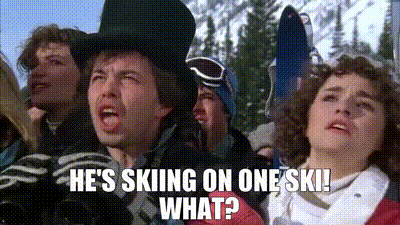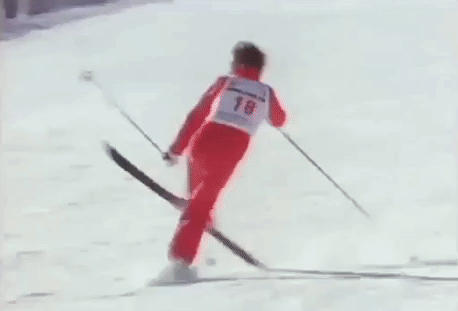What’s so great about an all-mountain ski?
Maybe I’m lazy. Maybe I like efficiency. Maybe I’m just cheap!
All or none of the above might be true.
In following with a similar theme from the recent post, titled Gravel Bike, the Goldilocks of Cycling, let’s head to the snowy slopes to discuss what’s so great about an all-mountain ski.
Similar to bicycles, there are all different types of skis that serve special purposes for terrain, sport, and conditions.
If you are a ski racer, you need a specific ski. If you are a powderhound who only likes to float on pillowy snow, you need a specific ski. Get my snow drift?
If you are like me, an intermediate to (maybe) advanced skier who’s wiling to take on nearly everything from on-piste to trees, to crud, to fluff, to bumps, then you’re looking for one ski to rule them all!
Enter the all-mountain ski
If you haven’t seen Better Off Dead, you need to watch it…tonight!
An all-mountain ski is a versatile type of ski that is designed to perform well across a variety of snow conditions and terrains. Whether you're skiing on groomed slopes, in powder, or tackling moguls, an all-mountain ski is engineered to handle it all.
Design and Construction
All-mountain skis typically feature a medium-width underfoot, ranging from around 85mm to 100mm. This width provides a good balance between stability on groomed runs and maneuverability in variable snow conditions. The ski's shape and construction may vary, but they often have a combination of camber and rocker, which helps with turning and floatation in soft snow.
Camber and Rocker Explained
According to REI.com, camber describes the shape of a traditional ski. Place one on a flat surface. It will rest on points near its tip and tail while its waist (midsection) arcs upward. This built-in arch is the camber of the ski.
Rocker is essentially the opposite of camber and is thus also known as reverse camber or negative camber. The side profile of a rockered ski resembles the upturned rails of an old-school rocking chair. On a flat surface, the midsection of a rockered ski will rest on the ground while its tips and tails rise off the ground much earlier than they do on a cambered ski.Camber puts springiness and pop into a ski. It permits easy handling, responsive turning, powerful carving, stability, and, due to ample edge contact with the snow, good grip on icy slopes.
Versatility
Image from skibrule.com
Versatility
They are designed to handle a wide range of conditions (akin to the all-mighty gravel bike), including groomed runs, ungroomed terrain, moguls, and even some powder. This versatility makes them a popular choice for skiers who enjoy exploring different parts of the mountain.
Performance on Groomed Runs
All-mountain skis typically perform well on groomed slopes. The camber underfoot provides good edge grip and stability, allowing for precise turns and carving. The width and shape of the ski also contribute to stability and control at higher speeds.
Off-Piste Performance
All-mountain skis excel in off-piste (away from groomed runs) conditions, such as trees and moguls. The rocker in the tip and tail helps with floatation and maneuverability in deeper snow, while the narrower waist allows for easier edge-to-edge transitions.
Powder Performance
While all-mountain skis are not specifically designed for deep powder, many models can handle moderate amounts of fresh snow. The wider waist provides more surface area, enhancing floatation and preventing the ski from sinking too deep into the snow.
Skill Level
All-mountain skis are typically suitable for intermediate to advanced skiers. Beginners may find them slightly more challenging due to their responsiveness and versatility.
Binding Compatibility
Image from corbetts.com Anatomy of a ski binding
When choosing all-mountain skis, it's important to ensure that the bindings you select are compatible with the ski's design. Most all-mountain skis are designed to accommodate bindings with a wide range of adjustability to fit different boot sizes and skiing styles.
I suggest you check out corbetts.com for a detailed guide on selecting the appropriate binding for your skis.
Length Selection
Image from blizzard-technica.com
The appropriate length of an all-mountain ski depends on various factors, including your skiing ability, weight, and preferred style. As a general guideline, shorter skis are more maneuverable, while longer skis offer more stability and floatation in deep snow.
When selecting a ski length, be honest about your ability and ski style. Check out blizzard-technicha.com for additional information on proper ski length selection.
Ski Boots
Pairing your all-mountain skis with suitable boots is crucial for optimal performance.
In fact, it’s my personal belief that proper-fitting, comfortable ski boots are more important than your skis. It’s hard to enjoy a day on the hill when your dogs are barking and your toes are numb.
Make sure to choose boots that are comfortable, provide good support, and are compatible with the bindings on your skis. Look to invest money in a boot fitting, and your investment will pay “comfort dividends” for years to come!
Personal Preference
Ultimately, the best all-mountain ski for you will depend on your personal preferences, skiing style, and the specific conditions you encounter most frequently. Be sure to test different models and seek advice from experienced skiers or knowledgeable professionals to find the right ski for your needs.
Remember, investing in high-quality skis and proper maintenance, such as regular waxing and tuning, will enhance the performance and longevity of your all-mountain skis.
Get out and explore the mountain
We’ve been given the gift of the great outdoors. Now that you know enough about all-mountain skis, pick up a pair and see where they will take you on that multi-condition mountain!
https://www.rei.com/learn/expert-advice/ski-rocker-technology.html
https://skibrule.com/camber-rocker/
https://www.corbetts.com/ski-binding-buying-guide/
https://www.blizzard-tecnica.com/assets/documents/blizzard/blizzard-ski-sizer_EN.pdf








